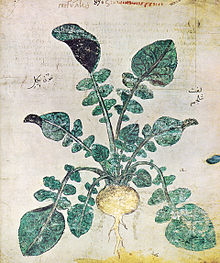Turnip
| Turnip | ||||||||||||
|---|---|---|---|---|---|---|---|---|---|---|---|---|

Turnip ( Brassica rapa subsp. Rapa ) |
||||||||||||
| Systematics | ||||||||||||
|
||||||||||||
| Scientific name | ||||||||||||
| Brassica rapa subsp. rapa | ||||||||||||
The turnip ( Brassica rapa subsp. Rapa ) is a subspecies within the cruciferous family (Brassicaceae). Forms of it are the May turnip , Teltower turnip , Pfatterer turnip , Gatower ball, autumn turnip and the closely related Bavarian turnip . It is to be distinguished from the turnips or turnips ( Brassica napus subsp. Napobrassica ; also: Brassica napus subsp. Rapifera ).
description
The turnip is a biennial herbaceous plant . It forms a turnip from the root and the hypocotyl . The shape and color of the beet are variable: the shape ranges from flattened-round to long conical, the color can be black, gray, white or yellow on the outside, and in the upper part of the beet also green or purple. The inside of the turnip is white or yellowish.
The leaves form a loose rosette at first, as the leaves sit directly on the beet, it does not form a recognizable "neck". A leafy, branched stem develops at the time of flowering . The lower stem leaves are petiolate. The leaf blades are pinnate and hairy with short bristles.
use
The turnip is used as a vegetable and as fodder . The young leaves are rarely used as leaf vegetables . The beets can be used raw or cooked, they are also acidified .
The turnip develops rapidly, so that it is possible to sow the turnip even after the grain harvest and to obtain harvestable plants by autumn (hence the names stubble, autumn beet). Sown in early spring, harvesting in May is possible (turnip). The cultivation is possible in moderate climates as well as in tropical altitudes. Some varieties can be harvested just 50 days after sowing, others take up to 100 days. There are also varieties that are sown in autumn, overwinter and then harvested in spring.
| Nutritional information per 100 g edible substance, fresh | water | Calorific value |
carbon hydrate |
protein | fat |
ballast substances |
Vitamin A | Vit. C | Vit. B 1 | Vit. B 2 | Vit. B 3 | Approx | P | K | N / A | Mg | Fe |
| turnip | 91.5% | 125 kJ (30 kcal) | 6.6 g | 1.00 g | 0.19 g | 0.90 g | traces | 30 mg | 0.05 mg | 0.06 mg | 6 mg | 39 mg | 32 mg | 207 mg | 50 mg | 15 mg | 0.5 mg |
| leaves | 90.5% | 117 kJ (28 kcal) | 5.2 g | 2.1 g | 0.35 g | 0.80 g | 5740 IU | 93 mg | 0.14 mg | 0.33 mg | 0.8 mg | 224 mg | 66 mg | 309 mg | 32 mg | 45 mg | 1.5 mg |
history
The turnip could have originated in eastern Afghanistan and western Pakistan, and the Mediterranean region is also an option. It found its early distribution in Asia Minor, the Romans and Greeks knew it already in pre-Christian times, early mentions of the turnip can be found in Greek and Roman texts. In the Vienna Dioscurides there is a colored illustration that shows a white, round turnip with pinnate, broadly rounded leaves at the end. The turnip is also found in the Middle Ages and in the herbal books of the Renaissance. Archaeological evidence of the seeds is made more difficult by the fact that the very similar wild turnip rape ( Brassica rapa ssp. Campestris ) was a widespread field weed. Turnip was also cultivated early in India and China.
Systematics
The turnip is regarded as a subspecies of the turnip ( Brassica rapa ). Some authors also separate the turnip as a separate species. Since the turnip is very variable, it has been described under numerous scientific names. Centers of diversity are Western Europe and Central Asia; some forms that appear originally from Afghanistan are described. One form of turnip is "Italian kale" or "Seven-top turnip" (formerly known as Brassica rapa var. Septiceps or Brassica septiceps ), from which the young leaves are used.
Individual evidence
- ↑ L. Reiner, H. Amon, A. Emmerling-Skala: The Bavarian turnip (Brassica rapa L. ssp. Rapa) - an almost extinct turnip. In: Samensurium. No. 12, 2001, pp. 35-53.
- ↑ a b Eckehart J. Jäger, Friedrich Ebel, Peter Hanelt, Gerd K. Müller (eds.): Exkursionsflora von Deutschland . Founded by Werner Rothmaler. tape 5 : Herbaceous ornamental and useful plants . Springer, Spektrum Akademischer Verlag, Berlin / Heidelberg 2008, ISBN 978-3-8274-0918-8 , pp. 252 .
- ↑ a b c d Udelgard Körber-Grohne: Useful plants in Germany from prehistory to today . Nikol, Hamburg 1995, ISBN 3-933203-40-6 , pp. 163-170 (licensed edition).
- ^ A b c Vincent E. Rubatzky, Mas Yamaguchi: World Vegetables . 2nd Edition. Aspen, Gaithersburg 1997, ISBN 0-8342-1687-6 , pp. 405-406 .
- ↑ a b c A. Diederichsen: Mansfeld's World Databas of Agricultural and Horticultural Crops. P. Hanelt / IPK Gatersleben, accessed on November 25, 2011 .
- ↑ Vincent E. Rubatzky, Mas Yamaguchi: World Vegetables . 2nd Edition. Aspen, Gaithersburg 1997, ISBN 0-8342-1687-6 , pp. 808 .
- ↑ Pedanius Dioscorides: The Vienna Dioscorides: Codex medicus Graecus 1 of the Austrian National Library . Graz: Academic Printing and Publishing Company (Highlights of Book Art; Volume 8/1). ISBN 3-201-01699-3 . Image: sheet 89r. Description: Comment p. 50.
- ^ GRIN Taxonomy for Plants. Taxon: Brassica rapa L. subsp. rapa. In: Germplasm Resources Information Network. United States Department of Agriculture - Agricultural Research Service, Beltsville Area, accessed February 18, 2012 .
